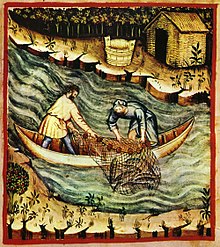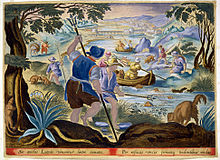Fishing
Fishing is a prehistoric practice dating back at least 70,000 years. Since the 16th century, fishing vessels have been able to cross oceans in pursuit of fish, and since the 19th century it has been possible to use larger vessels and in some cases process the fish on board. Fish are normally caught in the wild. Techniques for catching fish include hand gathering, spearing, netting, angling and trapping.
The term fishing may be applied to catching other aquatic animals such as shellfish, cephalopods, crustaceans and echinoderms. The term is not usually applied to catching aquatic mammals, such as whales, where the term whaling is more appropriate, or to farmed fish. In addition to providing food, modern fishing is also recreational sport.
According to FAO statistics, the total number of fishermen and fish farmers is estimated to be 38 million. Fisheries and aquaculture provide direct and indirect employment to over 500 million people.[1] In 2005, the worldwide per capita consumption of fish captured from wild fisheries was 14.4 kilograms, with an additional 7.4 kilograms harvested from fish farms.[2]
Prehistory
[edit]Fishing is an ancient practice that dates back at least to the Upper Paleolithic period which began about 40,000 years ago.[4][5] Isotopic analysis of the skeletal remains of Tianyuan man, a 40,000-year-old modern human from eastern Asia, has shown that he regularly consumed freshwater fish.[6][7] Archaeological features such as shell middens,[8] discarded fish bones and cave paintings show that sea foods were important for survival and consumed in significant quantities. During this period, most people lived a hunter-gatherer lifestyle and were, out of necessity, constantly on the move. However, where there are early examples of permanent settlements (though not necessarily permanently occupied) such as those at Lepenski Vir, they are almost always associated with fishing as a major source of food.
Spearfishing with barbed poles (harpoons) was widespread in palaeolithic times.[9] Cosquer cave in Southern France contains cave art over 16,000 years old, including drawings of seals which appear to have been harpooned.
The Neolithic culture and technology spread worldwide between 4,000 and 8,000 years ago. With the new technologies of farming and pottery came basic forms of the main fishing methods that are still used today.
From 7500 to 3000 years ago, Native Americans of the California coast were known to engage in fishing with gorge hook and line tackle.[10] In addition, some tribes are known to have used plant toxins to induce torpor in stream fish to enable their capture.[11]
Copper harpoons were known to the seafaring Harappans[12] well into antiquity.[13] Early hunters in India include the Mincopie people, aboriginal inhabitants of India's Andaman and Nicobar islands, who have used harpoons with long cords for fishing since early times.[14]
Early history
[edit]

The ancient river Nile was full of fish; fresh and dried fish were a staple food for much of the population.[15] The Egyptians invented various implements and methods for fishing and these are clearly illustrated in tomb scenes, drawings, and papyrus documents. Simple reed boats served for fishing. Woven nets, weir baskets made from willow branches, harpoons and hook and line (the hooks having a length of between eight millimetres and eighteen centimetres) were all being used. By the 12th dynasty, metal hooks with barbs were being used. As is fairly common today, the fish were clubbed to death after capture. Nile perch, catfish and eels were among the most important fish. Some representations hint at fishing being pursued as a pastime.

There are numerous references to fishing in ancient literature; in most cases, however, the descriptions of nets and fishing-gear do not go into detail, and the equipment is described in general terms. An early example from the Bible in Job 41:7: Canst thou fill his skin with barbed irons? or his head with fish spears?
Unlike in Minoan culture,[16] fishing scenes are rarely represented in ancient Greek culture, a reflection of the low social status of fishing.[citation needed] There is a wine cup, dating from c. 500 BC, that shows a boy crouched on a rock with a fishing-rod in his right hand and a basket in his left. In the water below there is a rounded object of the same material with an opening on the top. This has been identified as a fish-cage used for keeping live fish, or as a fish-trap. It is clearly not a net. This object is currently in the Museum of Fine Arts, Boston.[17]
Oppian of Corycus, a Greek author wrote a major treatise on sea fishing, the Halieulica or Halieutika, composed between 177 and 180. This is the earliest such work to have survived intact to the modern day. Oppian describes various means of fishing including the use of nets cast from boats, scoop nets held open by a hoop, spears and tridents, and various traps "which work while their masters sleep". Oppian's description of fishing with a "motionless" net is also very interesting:
- The fishers set up very light nets of buoyant flax and wheel in a circle round about while they violently strike the surface of the sea with their oars and make a din with sweeping blow of poles. At the flashing of the swift oars and the noise the fish bound in terror and rush into the bosom of the net which stands at rest, thinking it to be a shelter: foolish fishes which, frightened by a noise, enter the gates of doom. Then the fishers on either side hasten with the ropes to draw the net ashore.

The Greek historian Polybius (ca 203 BC–120 BC), in his Histories, describes hunting for swordfish by using a harpoon with a barbed and detachable head.[18]
Pictorial evidence of Roman fishing comes from mosaics which show fishing from boats with rod and line as well as nets. Various species such as conger, lobster, sea urchin, octopus and cuttlefish are illustrated.[19] In a parody of fishing, a type of gladiator called retiarius was armed with a trident and a casting-net. He would fight against the murmillo, who carried a short sword and a helmet with the image of a fish on the front.
The Greco-Roman sea god Neptune is depicted as wielding a fishing trident.

In India, the Pandyas, a classical Dravidian Tamil kingdom, were known for the pearl fishery as early as the 1st century BC. Their seaport Tuticorin was known for deep sea pearl fishing. The paravas, a Tamil caste centred in Tuticorin, developed a rich community because of their pearl trade, navigation knowledge and fisheries.
In Norse mythology the sea giantess Rán uses a fishing net to trap lost sailors.
The Moche people of ancient Peru depicted fisherman in their ceramics.[20]
From ancient representations and literature it is clear that fishing boats were typically small, lacking a mast or sail, and were only used close to the shore.
In traditional Chinese history, history begins with three semi-mystical and legendary individuals who taught the Chinese the arts of civilization around 2800–2600 BC: of these Fuxi was reputed to be the inventor of writing, hunting, trapping, and fishing.

![Hook and sinker from the Late Epipalaeolithic[3]](https://upload.wikimedia.org/wikipedia/commons/thumb/0/06/Reconstruction_of_a_prehistoric_hook_and_sinker.png/166px-Reconstruction_of_a_prehistoric_hook_and_sinker.png)